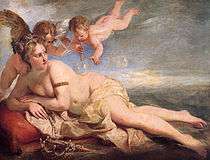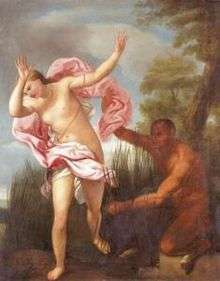Giovanni Segala
Giovanni Segala (1663-1720) was a Venetian painter.
Giovanni Segala | |
|---|---|
| Born | 1663 |
| Died | 1720 |
| Nationality | Venetian |
| Occupation | Painter |
Life
Giovanni Segala was born in Murano in 1663.[1] He studied under Antonio Zanchi.[2] He was also a pupil of Pietro della Vecchia and was influenced by his contemporary Gregorio Lazzarini. He undertook work for Venetian churches such as San Pantalon and San Martino.[1] The San Clemente Church on the Isola di San Clemente has one of his paintings.[3] He gained a solid reputation for his depictions of historical subjects.[2] Between 1688 and 1692 he worked for the Marquis von Platen in Hanover.[1]
Style
Segala was one of the more distinguished of the Venetian artists of the 18th century, although not the equal of masters such as Giovanni Battista Tiepolo or Sebastiano Ricci.[4] He developed a fluid style with delicate colors and a soft light.[1] He followed his teachers in using deep shadows in his work, perhaps excessively, but made skilled use of illumination. The picture of the Conception, which he made for the college of La Carità, was highly praised by Zanetti and is said to be equal to those of the finest artists of his day.[5]
Gallery
 Madonna and Child with the Young Saint John
Madonna and Child with the Young Saint John Adoration of the Magi
Adoration of the Magi Allegory of Vanity
Allegory of Vanity
References
Citations
- Segala, Giovanni: Treccani.
- Bryan 1816, p. 390.
- San Clemente Church: San Clemente Palace.
- Wornum 1847, p. 404-405.
- Lanzi 1878, p. 295.
Sources
| Wikimedia Commons has media related to Giovanni Segala. |
- Bryan, Michael (1816). A Biographical and Critical Dictionary of Painters and Engravers: From the Revival of the Art Under Cimabue, and the Alleged Discovery of Engraving by Finiguerra, to the Present Time : with the Ciphers, Monograms, and Marks, Used by Each Engraver, and an Ample List of Their Principal Works, Together with Two Indexes, Alphabetical and Chronological, to which is Prefixed, an Introduction, Containing a Brief Account of the Painters of Antiquity. Carpenter and Son; J. Booker; and Whittingham and Arliss. p. 390. Retrieved 2013-11-25.CS1 maint: ref=harv (link)
- Lanzi, Luigi (1878). The History of Painting in Italy: From the Period of the Revival of the Fine Arts to the End of the Eighteenth Century. G. Bell. Retrieved 2013-11-25.CS1 maint: ref=harv (link)
- "San Clemente Church". San Clemente Palace Hotel & Resort. Permak Investments. Archived from the original on 2013-12-03. Retrieved 2013-11-22.
- Segala, Giovanni. Treccani. Retrieved 2013-11-24.
- Wornum, Ralph Nickolson (1847). The epochs of painting characterized, a sketch of the history of painting, ancient and modern. Cox. p. 404. Retrieved 2013-11-25.CS1 maint: ref=harv (link)
